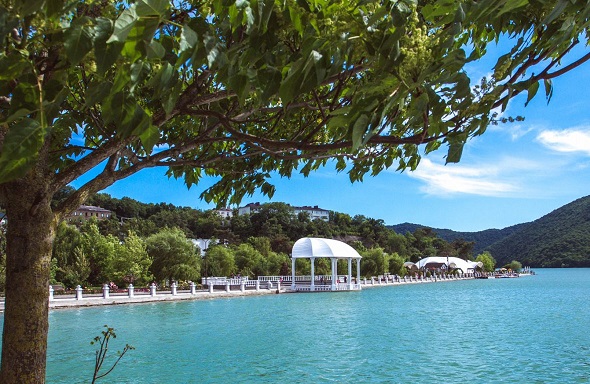

Abrau-Dyurso is a village (formerly an urban-type settlement) in the Krasnodar Kray. The administrative center of the rural district Abrau-Dyurso of the municipal formation is the city of Novorossiysk.
There are mass recreation areas in the area of the settlement.
There is a champagne museum in Abrau-Durso. Since May 1, 2016, the
"M'ARS Center for Contemporary Art" has been operating in the building
of the old champagne factory
From September 7 to September 11,
2016, the youth educational "Growth Forum" was held in the village by
the Party of Growth.
The name of the village Abrau was formed from the toponym of the Adygs. Abragio. Meanwhile, there are other options for the formation of the toponym, for example, from ancient Iranians. Abrau - "sky" or abh. Abrau - "hollow", Turk. dur - "transparent" and Turk. su - "river". Durso (Adyghe Dursu - “four springsâ€) is a river that flows into the lake to the west of the Abrau River. Adyghe legend says:
Abrau-Dyurso is located 14 km west of Novorossiysk (with which it is
connected by a highway) and 5 km north of the sea coast. The village is
located on the shore of the Abrau mountain lake, at the confluence of
the Abrau river of the same name. A dam once formed at the confluence
with the Abrau River, which led to the formation of Lake Abrau-Dyurso.
The village has a small strip of pebble beach, separated on both sides
by rocks, behind which a wild beach begins. On one side of it are the
recreation centers "Moryak" and "Fregat", and on the other - Maly Liman
(Limanchik) - a small but picturesque fresh lake on the seashore. In
Lake Abrau, the water is warm, clean, but muddy due to limestone. Since
2012 in Abrau-Dyurso there has been a sports training base "Football
World", where football tournaments and training sessions of football
teams of Russian divisions are held.
Before the formation of the royal estate, there was an Adyg village
called Adyg. EkIeh (another name - Adyg. Abrago) - "failed". After the
end of the Caucasian War and the deportation of the Circassians in 1870,
by the order of the head of the Black Sea District, Major General D.V.
Pilenko, the specific estate of the royal family of Abrau-Dyurso was
founded.
The allocation of land for the Appanage Department was
made in 1871. During the first land surveying, the area under forest,
meadows and steppe was over 7.2 thousand dessiatines. Experiments on the
cultivation of grapes were started under the leadership of the
agronomist of the Black Sea region F.I.Geyduk, who in 1872 bought the
selection of Rhine grape vines of the Riesling and Portugieser varieties
from abroad. In 1873-1874, a part (about 8 thousand bushes) was planted
in Abrau-Dyurso on a plantation with an area of ​​over 3.2 thousand
square fathoms. Later, the varieties Sauvignon, Pinot-fran and
Pinot-gris, Traminer, etc. were also cultivated here.
The first
grape harvest in Abrau-Dyurso was harvested in 1877. In 1882, a special
cellar was built, equipped for the production of wine (in 1886 - the
second cellar for 13.6 thousand buckets). By 1882, the winemaker E. A.
Wedel created vintage table wines "Riesling" and "Cabernet Abrau". By
the mid-1890s, the types of vintage Abrau-Durso wines were finally
formed: such as "Sauternes", "Lafite", "Bordeaux", "Burgundy".
In
1891, Prince L. S. Golitsyn was appointed chief winemaker of the
Appanage Department. In accordance with his recommendations,
Abrau-Dyurso has begun preparations for the preparation of sparkling
wine by the champagne method (fr. Méthode champenoise) and the
construction of improved cellars. Since 1893, champagne varieties of
grapes were bred, and soon they occupied about half of the entire
vineyard area. In 1894-1900, a factory building, 5 basements-tunnels
were built in Abrau-Dyurso, a highway to Novorossiysk was laid. In 1898,
the first batch of Abrau champagne was produced. In 1899, the entire
staff of specialists in the production of champagne was transferred from
Sudak to Abrau-Dyurso.
In 1920, on the basis of the former
imperial estate, the Abrau-Dyurso wine-making state farm was created.
During this period, the head of the enterprise was AM Frolov-Bagreev
(1877-1953) - the founder of the Soviet variety of the reservoir method
for the production of sparkling wines. The first circulation of Soviet
champagne in the amount of 36 thousand bottles was produced by the
reservoir method under the leadership of A.M. Frolov-Bagreev in 1928.
On July 28, 1936, at a meeting of the Politburo, with the personal
participation of I. V. Stalin, the Resolution of the Council of People's
Commissars of the USSR and the Central Committee of the All-Union
Communist Party of Bolsheviks "On the production of Soviet champagne,
dessert and table wines" was adopted. This decree provided for the
introduction of widespread production of "Soviet Champagne" by the
reservoir method at existing plants (including the Abrau-Dyurso plant).
On February 5, 1937, the Resolution of the Council of People's
Commissars of the USSR No. 213 "On expanding the raw material base for
the production of Soviet champagne and high-quality dessert wines in the
collective farms of the RSFSR" was issued for use by the Abrau-Dyurso
enterprise (p. 1):
To concentrate the raw material base for the
production of Soviet champagne in the RSFSR: a) mainly - on the
territory adjacent to the location of the existing champagne production
at the Abrau-Dyurso state farm: in the regions of Novorossiysk, Anapa,
Gelendzhik and Temryuk, Azov-Black Sea region.
The state farm and the Abrau-Dyurso plant were separated into a
separate settlement (workers' settlement) on July 23, 1948. At the end
of the 2000s, the urban-type settlement Abrau-Dyurso was transformed
into a village.